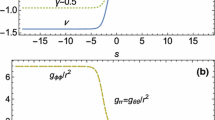Abstract
We have established the exact expression for the gravitational potential of a homogeneous polar cell—an elementary pattern used in hydrodynamical simulations of gravitating discs. This formula, which is a closed-form, works for any opening angle and radial extension of the cell. It is valid at any point in space, i.e. in the plane of the distribution (inside and outside) as well as off-plane, thereby generalizing the results reported by Durand (Electrostatique. Vol. I. Les Distributions, 1953) for the circular disc. The three components of the gravitational acceleration are given. The mathematical demonstration proceeds from the incomplete version of Durand’s formula for the potential (based on complete elliptic integrals). We determine first the potential due to the circular sector (i.e. a pie-slice sheet), and then deduce that of the polar cell (from convenient radial scaling and subtraction). As a by-product, we generate an integral theorem stating that “the angular average of the potential of any circular sector along its tangent circle is \({\frac{2}{\pi}}\) times the value at the corner”. A few examples are presented. For numerical resolutions and cell shapes commonly used in disc simulations, we quantify the importance of curvature effects by performing a direct comparison between the potential of the polar cell and that of the Cartesian (i.e. rectangular) cell having the same mass. Edge values are found to deviate roughly like \({2 \times 10^{-3}\times N/256}\) in relative (N is the number of grid points in the radial direction), while the agreement is typically four orders of magnitude better for values at the cell’s center. We also produce a reliable approximation for the potential, valid in the cell’s plane, inside and close to the cell. Its remarkable accuracy, about \({5\times 10^{-4}\times N/256}\) in relative, is sufficient to estimate the cell’s self-acceleration.
Similar content being viewed by others
References
Arnaboldi M., Sparke L.S.: Self-gravitating polar rings in axisymmetric and triaxial galaxy potentials. Astron. J. 107, 958–970 (1994). doi:10.1086/116909
Baruteau, C., Masset, F.: Type I planetary migration in a self-gravitating disk. Astrophys. J. 678, 483–497 (2008) doi:10.1086/529487
Binney J., Tremaine S.: Galactic dynamics, pp. 747. Princeton University Pres, Princeton, NJ (1987)
Brada, R., Milgrom, M.: Finite disks with power-law potentials. Astrophys. J. 444, 71–79 (1995). doi:10.1086/175583
Casertano S.: Rotation curve of the edge-on spiral galaxy NGC 5907: disc and halo masses. Mon. Not. R. Astr. Soc. 203, 735–747 (1983)
Chappell, J.M., Chappell, M.J., Iqbal, A., Abbott, D.: The gravitational field of a cube. ArXiv e-prints (2012)
Conway J.T.: Analytical solutions for the newtonian gravitational field induced by matter within axisymmetric boundaries. Mon. Not. R. Astr. Soc. 316, 540–554 (2000). doi:10.1046/j.1365-8711.2000.03523.x
Dieckmann, A.: (private communication) (2011)
Durand, E.: Électrostatique. Vol. I. Les Distributions, Masson, Paris (1953)
Evans N.W., Collett J.L.: Simple discs with flat rotation curves. Mon. Not. R. Astr. Soc. 264, 353–374 (1993)
Fukushima T.: Precise computation of acceleration due to uniform ring or disk. Celest. Mechan. Dynam. Astron. 108, 339–356 (2010). doi:10.1007/s10569-010-9304-4
Gradshteyn I.S., Ryzhik I.M.: Table of Integrals, Series, and Products, Seventh Edition. Academic Press, (2007)
Huré, J.M., Pelat, D., Pierens, A.: Generation of potential/surface density pairs in flat disks. Power law distributions. Astron. Astrophys. 475, 401–407 (2007). doi:10.1051/0004-6361:20066808
Huré, J.M., Pierens, A., Hersant, F.: Self-gravity at the scale of the polar cell. Astron. Astrophys. 500, 617–620 (2009). doi:10.1051/0004-6361/200911806
Kalnajs A.J.: Dynamics of flat galaxies. II. Biorthonormal surface density-potential pairs for finite disks. Astrophys. J. 205, 745–750 (1976). doi:10.1086/154330
Lass H., Blitzer L.: The gravitational potential due to uniform disks and rings. Celest. Mechan. 30, 225–228 (1983). doi:10.1007/BF01232189
Mestel, L.: On the galactic law of rotation. Mon. Not. R. Astr. Soc. 126, 553 (1963)
Nelson, A.F.: Numerical requirements for simulations of self-gravitating and non-self-gravitating discs. Mon. Not. R. Astr. Soc. 373, 1039–1073 (2006). doi:10.1111/j.1365-2966.2006.11119.x
Pierens, A., Baruteau, C., Hersant, F.: On the dynamics of resonant super-Earths in disks with turbulence driven by stochastic forcing. Astron. Astrophys. 531, A5 (2011). doi:10.1051/0004-6361/201116611
Qian E.: Potential-density pairs for flat discs. Mon. Not. R. Astr. Soc. 257, 581–592 (1992)
Quan, E.E.: Biorthogonal potential density sets for flat discs. Mon. Not. R. Astr. Soc. 263, 394 (1993)
Schulz, E.: Potential-density pairs for a family of finite disks. Astrophys. J. 693, 1310–1315 (2009). doi:10.1088/0004-637X/693/2/1310
Schulz, E.: The gravitational force and potential of the finite mestel disk. Astrophys. J. 747, 106 (2012). doi:10.1088/0004-637X/747/2/106
Šubr, L., Karas, V.: A manifestation of the Kozai mechanism in the galactic nuclei. In: Hledík, S., Stuchlík, Z. (eds.) RAGtime 6/7: Workshops on Black Holes and Neutron Stars, pp. 281–293 (2005)
Tresaco, E., Elipe, A., Riaguas, A.: Dynamics of a particle under the gravitational potential of a massive annulus: properties and equilibrium description. Celest. Mech. Dynam. Astron. 111, 431–447 (2011). doi:10.1007/s10569-011-9371-1
van de Vel, H.: On the series expansion method for computing incomplete elliptic integrals of the first and second kinds. Math. Comp. 23 (105), 6169 (1969). doi:10.1090/S0025-5718-1969-0239732-8
Vogt, D., Letelier, P.S.: Analytical potential-density pairs for flat rings and toroidal structures. Mon. Not. R. Astr. Soc. 396, 1487–1498 (2009) doi:10.1111/j.1365-2966.2009.14803.x
Zhu, P.: Field distribution of a uniformly charged circular arc. J. Electrostat. 63(11), 1035–1047 (2005). doi:10.1016/j.elstat.2005.02.001, URL http://www.sciencedirect.com/science/article/pii/S0304388605000148
Author information
Authors and Affiliations
Corresponding author
Electronic Supplementary Material
The Below is the Electronic Supplementary Material.
Rights and permissions
About this article
Cite this article
Huré, JM. A key-formula to compute the gravitational potential of inhomogeneous discs in cylindrical coordinates. Celest Mech Dyn Astr 114, 365–385 (2012). https://doi.org/10.1007/s10569-012-9445-8
Received:
Revised:
Accepted:
Published:
Issue Date:
DOI: https://doi.org/10.1007/s10569-012-9445-8



